Friction and Wear of Oxide Scale Obtained on Pure Titanium after High-Temperature Oxidation
Abstract
:1. Introduction
2. Materials and Methods
3. Results and Discussion
3.1. Microstructure of the Oxide Scales
3.2. Oxide Scale Hardness
3.3. Resistance to Sliding Wear of Titanium after High-Temperature Oxidation
3.4. Wear Ratio of the Balls
3.5. Friction Coefficient
3.6. Microscopic Analysis of the Friction Surface
4. Conclusions
- The oxide scales obtained on titanium in high-temperature oxidation were of good quality. The scale microstructure was strictly dependent on the oxidation parameters. The effect of increasing the heat treatment temperature was that the scales became more homogeneous.
- The study showed that the oxide scales obtained after oxidation for 72 h were characterized by higher hardness (ca. 1260 kgf/mm2). After oxidation over a period of 24 h, the hardness of those scales was from 892.4 HV to 1146.6 kgf/mm2. It was shown that in a shorter oxidation time-variant (24 h), the hardness of the scale increased with temperature. After 72 h of oxidation, no similar dependence was found. At the same time it was shown that after oxidation at 750 °C, there was a reduction in hardness (both after 24 h and 72 h of oxidation), which could be connected with the formation of a thicker scale with worse adhesion.
- During tribological tests with titanium Grade 2 in a non-oxidized condition, the friction coefficient was approx. 0.6–0.75 (depending on the counter specimen used). After heat treatment, a ca. 40–50% increase of the friction coefficient was observed. During the stabilized phase of the tribological tests, it was shown that the friction coefficient reduced.
- Oxidation of the titanium surface resulted in a visible improvement of the tribological characteristics. The oxide films produced at a temperature range of 600–750 °C caused a reduction of the wear ratio, dependent on the sliding couple used and the oxidation parameters. The highest resistance to wear was found during cooperation with 100Cr6 bearing steel.
- Analysis of the results of wear ratio of Al2O3, ZrO2, and 100Cr6 balls after frictional contact with titanium Grade 2 in the non-oxidized condition showed that the highest wear occurred in the titanium/Al2O3 sliding couple. For the ZrO2 balls, the wear was nearly 7 times lower. As regards the wear of the balls made of 100Cr6 bearing steel, it was more than 2 times higher than for the ZrO2 balls and, at the same time, nearly 3 times lower compared to the Al2O3 balls.
- A sliding interaction of Al2O3 balls with an oxidized titanium Grade 2 disc resulted in a reduction in the wear ratio, but only for the oxide scales obtained at 600 °C (24 h, 72 h) and 650 °C (24 h). In tribological tests with ZrO2 balls, an increased intensity of wear was observed for the balls, especially during cooperation with the scales which formed at a temperature of 650 °C or higher. The increase in wear intensity after oxidation was also observed for the 100Cr6 steel.
- Microscopic observation of the friction surface on titanium in a non-oxidized condition revealed the presence of the so-called corrugation wear. It was shown that high-temperature oxidation eradicated this phenomenon.
- The best tribological properties of titanium Grade 2 during sliding interaction with Al2O3 balls are ensured by oxide scales obtained at 700 °C after both 24 h and 72 h oxidation. Based on tests with ZrO2 and 100Cr6 balls, it was shown that titanium can achieve the best wear resistance after oxidation at the lowest temperature (600 °C—24 h, 72 h).
- High-temperature oxidation is an effective method for significantly improving the poor tribological properties of titanium Grade 2. By varying the temperature and time parameters of the oxidation process, the tribological characteristics of the friction couples studied can be changed over a wide range.
Author Contributions
Funding
Institutional Review Board Statement
Informed Consent Statement
Data Availability Statement
Conflicts of Interest
References
- Daudt, N.F.; Hackemüller, F.J.; Bram, M. Manufacturing of Ti-10Nb based metal sheets by tape casting. Mater. Lett. 2019, 237, 161–164. [Google Scholar] [CrossRef]
- Ureña, J.; Tabares, E.; Tsipas, S.; Jiménez-Morales, A.; Gordo, E. Dry sliding wear behaviour of β-type Ti-Nb and Ti-Mo surfaces designed by diffusion treatments for biomedical applications. J. Mech. Behav. Biomed. Mater. 2019, 91, 335–344. [Google Scholar] [CrossRef]
- Leo, J.R.O.; Pirfo Barroso, S.; Fitzpatrick, M.E.; Wand, M.; Zhou, Z. Microstructure, tensile and creep properties of an austenitic ODS 316L steel. Mater. Sci. Eng. A 2019, 749, 158–165. [Google Scholar] [CrossRef]
- Zaman, H.A.; Sharif, S.; Kim, D.-W.; Idris, M.H.; Suhaimi, M.A.; Tumurkhuyag, Z. Machinability of Cobalt-based and Cobalt Chromium Molybdenum Alloys—A Review. Proc. Manuf. 2017, 11, 563–570. [Google Scholar] [CrossRef]
- Romanov, D.A.; Sosnin, K.V.; Gromov, V.E.; Bataev, V.A.; Ivanov, Y.F.; Glezer, A.M.; Sundeev, R.V. Titanium-zirconium coatings formed on the titanium implant surface by the electroexplosive method. Mater. Lett. 2019, 242, 79–82. [Google Scholar] [CrossRef]
- Hryniewicz, T.; Rokosz, K.; Valíček, J.; Rokicki, R. Effect of magnetoelectropolishing on nanohardness and Young’s modulus of titanium biomaterial. Mater. Lett. 2012, 83, 69–72. [Google Scholar] [CrossRef]
- Beshchasna, N.; Kwan Hoa, A.Y.; Saqib, M.; Kraśkiewicz, H.; Wasyluk, Ł.; Kuzmin, O.; Duta, O.C.; Ficai, D.; Trusca, R.D.; Ficai, A.; et al. Surface evaluation of titanium oxynitride coatings used for developing layered cardiovascular stents. Mater. Sci. Eng. C 2019, 99, 405–416. [Google Scholar] [CrossRef]
- Szaraniec, B.; Pielichowska, K.; Paca, E.; Menaszek, E. Multifunctional polymer coatings for titanium implants. Mater. Sci. Eng. C 2018, 93, 950–957. [Google Scholar] [CrossRef]
- Sengupta, B.; Shekhar, S.; Kulkarni, K.N. A novel ultra-high strength and low-cost as-cast titanium alloy. Mater. Sci. Eng. A 2017, 696, 478–481. [Google Scholar] [CrossRef]
- Singh, P.; Pungotra, H.; Kalsi, N.S. On the characteristics of titanium alloys for the aircraft applications. Mater. Today Proceed. 2017, 4, 8971–8982. [Google Scholar] [CrossRef]
- Dai, J.; Zhu, J.; Chen, C.; Weng, F. High temperature oxidation behavior and research status of modifications on improving high temperature oxidation resistance of titanium alloys and titanium aluminides: A review. J. Alloys Compd. 2016, 685, 784–798. [Google Scholar] [CrossRef]
- Philip, J.T.; Mathew, J.; Kuriachen, B. Tribology of Ti6Al4V: A review. Friction 2019, 7, 497–536. [Google Scholar] [CrossRef] [Green Version]
- Revankar, G.D.; Shetty, R.; Rao, S.S.; Gaitonde, V.N. Wear resistance enhancement of titanium alloy (Ti–6Al–4V) by ball burnishing process. J. Mater. Res. Technol. 2017, 6, 13–32. [Google Scholar] [CrossRef] [Green Version]
- Jaber Razavi Arab, S.; Aghajani, H. Wear Behavior of Pure Titanium Coated With WC-Co by the Use of Electrospark Deposition Method. J. Tribol. 2019, 141, 051605. [Google Scholar] [CrossRef]
- Cui, X.H.; Mao, Y.S.; Wei, M.X.; Wang, S.Q. Wear Characteristics of Ti-6Al-4V Alloy at 20–400 °C. Tribol. Trans. 2012, 55, 185–190. [Google Scholar] [CrossRef]
- Zhang, Q.; Guo, X.; Zhang, M.; Ding, H.; Zhou, G. Severe-to-Mild Wear Transition of Ti–6.5Al–3.5Mo–1.5Zr–0.3Si Alloy Accelerated by Fe-Rich Oxide Tribo-layers. Tribol. Lett. 2019, 67, 17. [Google Scholar] [CrossRef]
- Klekotka, M.; Dąbrowski, J.R.; Rećko, K. Fretting and Fretting Corrosion Processes of Ti6Al4V Implant Alloy in Simulated Oral Cavity Environment. Materials 2020, 13, 1561. [Google Scholar] [CrossRef] [Green Version]
- Zhang, Y.; Ma, G.-R.; Zhang, X.C.; Li, S.; Tu, S.-T. Thermal oxidation of Ti-6Al–4V alloy and pure titanium under external bending strain: Experiment and modelling. Corr. Sci. 2017, 122, 61–73. [Google Scholar] [CrossRef]
- Aniołek, K.; Barylski, A.; Kupka, M. Modelling the structure and mechanical properties of oxide layers obtained on biomedical Ti-6Al-7Nb alloy in the thermal oxidation process. Vacuum 2018, 154, 309–314. [Google Scholar] [CrossRef]
- Li, L.; Yu, K.; Zhang, K.; Liu, Y. Study of Ti–6Al–4V alloy spectral emissivity characteristics during thermal oxidation process. Int. J. Heat Mass Trans. 2016, 101, 699–706. [Google Scholar] [CrossRef]
- Luo, Y.; Chen, W.; Tian, M.; Teng, S. Thermal oxidation of Ti6Al4V alloy and its biotribological properties under serum lubrication. Tribol. Int. 2015, 89, 67–71. [Google Scholar] [CrossRef]
- Kumar, S.; Sankara Narayanan, T.S.N.; Ganesh Sundara Raman, S.; Seshadri, S.K. Thermal oxidation of Ti6Al4V alloy: Microstructural and electrochemical characterization. Mater. Chem. Phys. 2010, 119, 337–346. [Google Scholar] [CrossRef]
- Wang, S.; Liao, Z.; Liu, Y.; Liu, W. Influence of thermal oxidation duration on the microstructure and fretting wear behavior of Ti6Al4V alloy. Mater. Chem. Phys. 2015, 159, 139–151. [Google Scholar] [CrossRef]
- Aniołek, K. The influence of thermal oxidation parameters on the growth of oxide layers on titanium. Vacuum 2017, 144, 94–100. [Google Scholar] [CrossRef]
- Kumar, S.; Sankara Narayanan, T.S.N.; Ganesh Sundara Raman, S.; Seshadri, S.K. Thermal oxidation of CP Ti—An electrochemical and structural characterization. Mater. Character. 2010, 61, 589–597. [Google Scholar] [CrossRef]
- Ashrafizadeh, A.; Ashrafizadeh, F. Structural features and corrosion analysis of thermally oxidized titanium. J. Alloys Comp. 2009, 480, 849–852. [Google Scholar] [CrossRef]
- Biswas, A.; Majumdar, J.D. Surface characterization and mechanical property evaluation of thermally oxidized Ti-6Al-4V. Mater. Character. 2009, 60, 513–518. [Google Scholar] [CrossRef]
- Bailey, R.; Sun, Y. Unlubricated sliding friction and wear characteristics of thermally oxidized commercially pure titanium. Wear 2013, 308, 61–70. [Google Scholar] [CrossRef]
- Dalili, N.; Edrisy, A.; Farokhzadeh, K.; Li, J.; Lo, J.; Riahi, A.R. Improving the wear resistance of Ti–6Al-4V/TiC composites through thermal oxidation (TO). Wear 2010, 269, 590–601. [Google Scholar] [CrossRef]
- Guleryuz, H.; Cimenoglu, H. Surface modification of a Ti–6Al–4V alloy by thermal oxidation. Surf. Coat. Technol. 2005, 192, 164–170. [Google Scholar] [CrossRef]
- Arslan, E.; Totik, Y.; Demirci, E.; Alsaran, A. Influence of Surface Roughness on Corrosion and Tribological Behavior of CP-Ti After Thermal Oxidation Treatment. J. Mater. Eng. Perform. 2010, 19, 428–433. [Google Scholar] [CrossRef]
- Liu, J.; Suslov, S.; Li, S.; Qin, H.; Ren, Z.; Ma, C.; Wang, G.-X.; Doll, G.L.; Cong, H.; Dong, Y.; et al. Effects of ultrasonic nanocrystal surface modification on the thermal oxidation behavior of Ti6Al4V. Surf. Coat. Technol. 2017, 325, 289–298. [Google Scholar] [CrossRef]
- Aniołek, K.; Kupka, M.; Barylski, A.; Mieszczak, Ł. Characteristic of oxide layers obtained on titanium in the process of thermal oxidation. Arch. Metall. Mater. 2016, 61, 853–856. [Google Scholar] [CrossRef]
- Bianchi, M.; Gambardella, A.; Berni, M.; Panseri, S.; Montesi, M.; Lopomo, N.; Tampieri, A.; Marcacci, M.; Russo, A. Surface morphology, tribological properties and in vitro biocompatibility of nanostructured zirconia thin films. J. Mater. Sci. Mater. Med. 2016, 96, 27–96. [Google Scholar] [CrossRef]
- Wang, S.; Liao, Z.; Liu, Y.; Liu, W. Influence of thermal oxidation temperature on the microstructural and tribological behavior of Ti6Al4V alloy. Surf. Coat. Technol. 2014, 240, 470–477. [Google Scholar] [CrossRef]
- Siva Rama Krishna, D.; Brama, Y.L.; Sun, Y. Thick rutile layer on titanium for tribological applications. Tribol. Int. 2007, 40, 329–334. [Google Scholar] [CrossRef]
- Dearnley, P.A.; Dahm, K.L.; Cimenoglu, H. The corrosion–wear behaviour of thermally oxidised CP-Ti and Ti–6Al–4V. Wear 2004, 256, 469–479. [Google Scholar] [CrossRef]
- Grassie, S.L. Rail corrugation: Characteristics, causes, and treatments. Proceed. Inst. Mech. Eng. Part F J. Rail Rapid Transit 2009, 223, 581–596. [Google Scholar] [CrossRef]
- Suszko, T.; Gulbiński, W.; Jagielski, J. The role of surface oxidation in friction processes on molybdenum nitride thin films. Surf. Coat. Technol. 2005, 194, 319–324. [Google Scholar] [CrossRef]
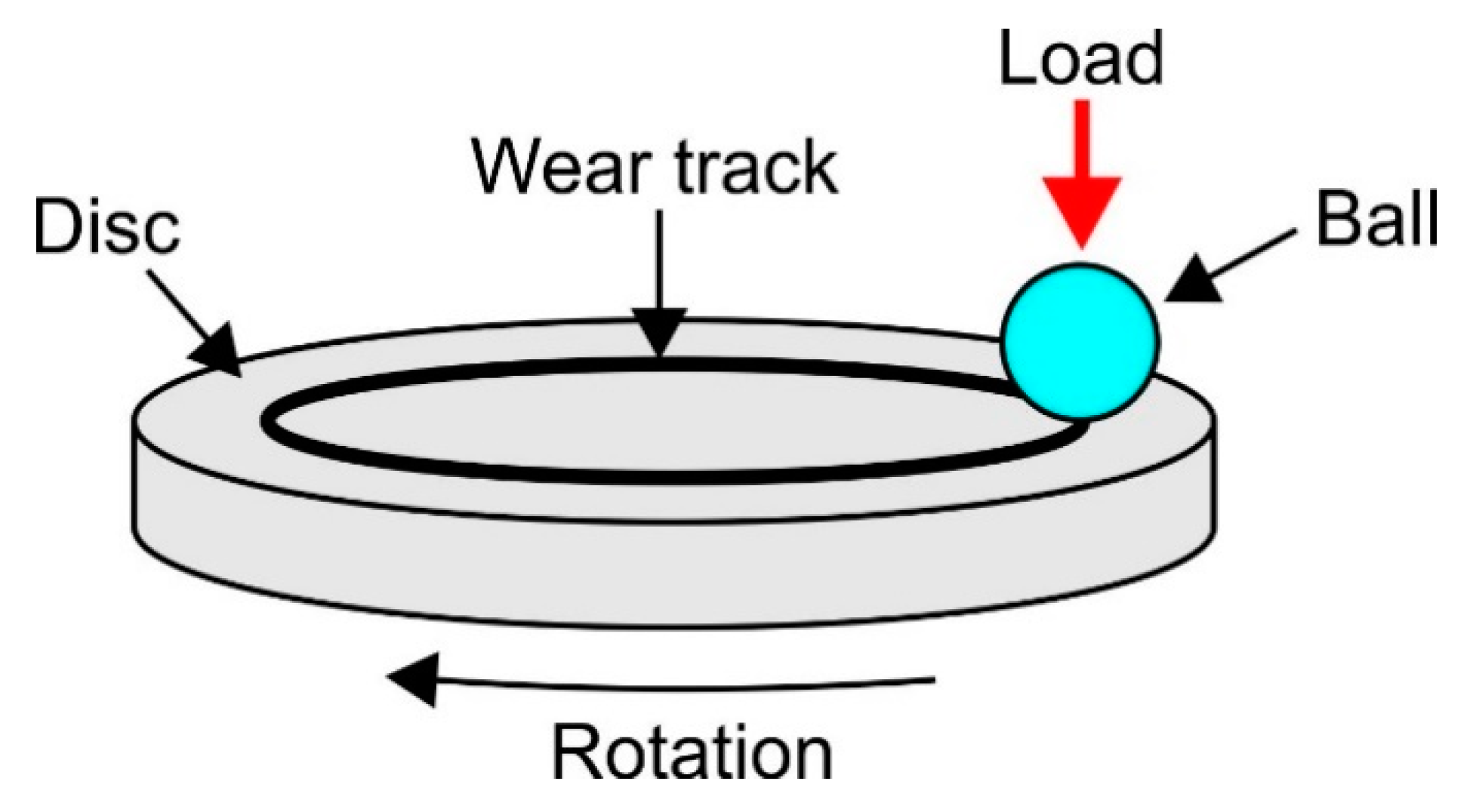
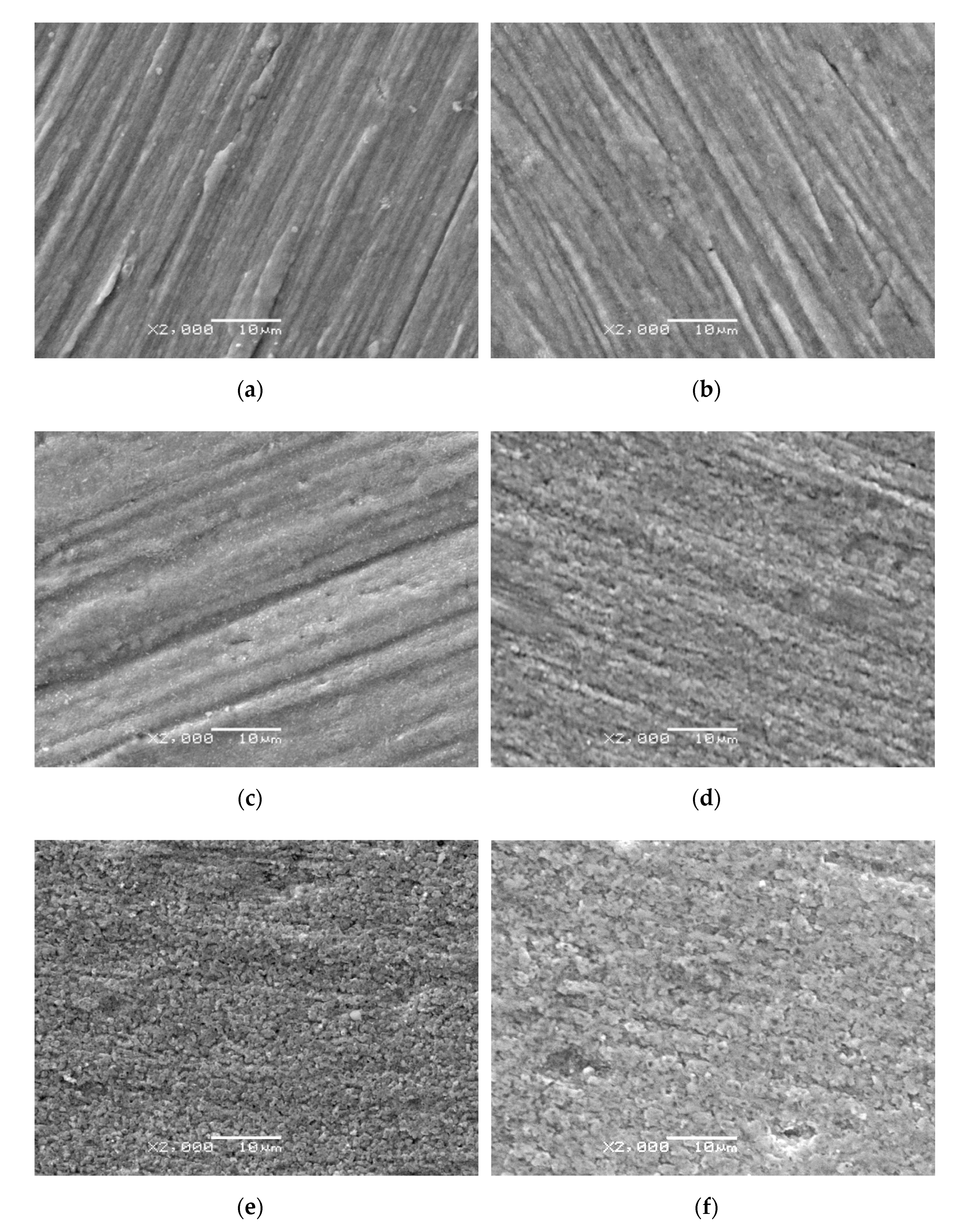
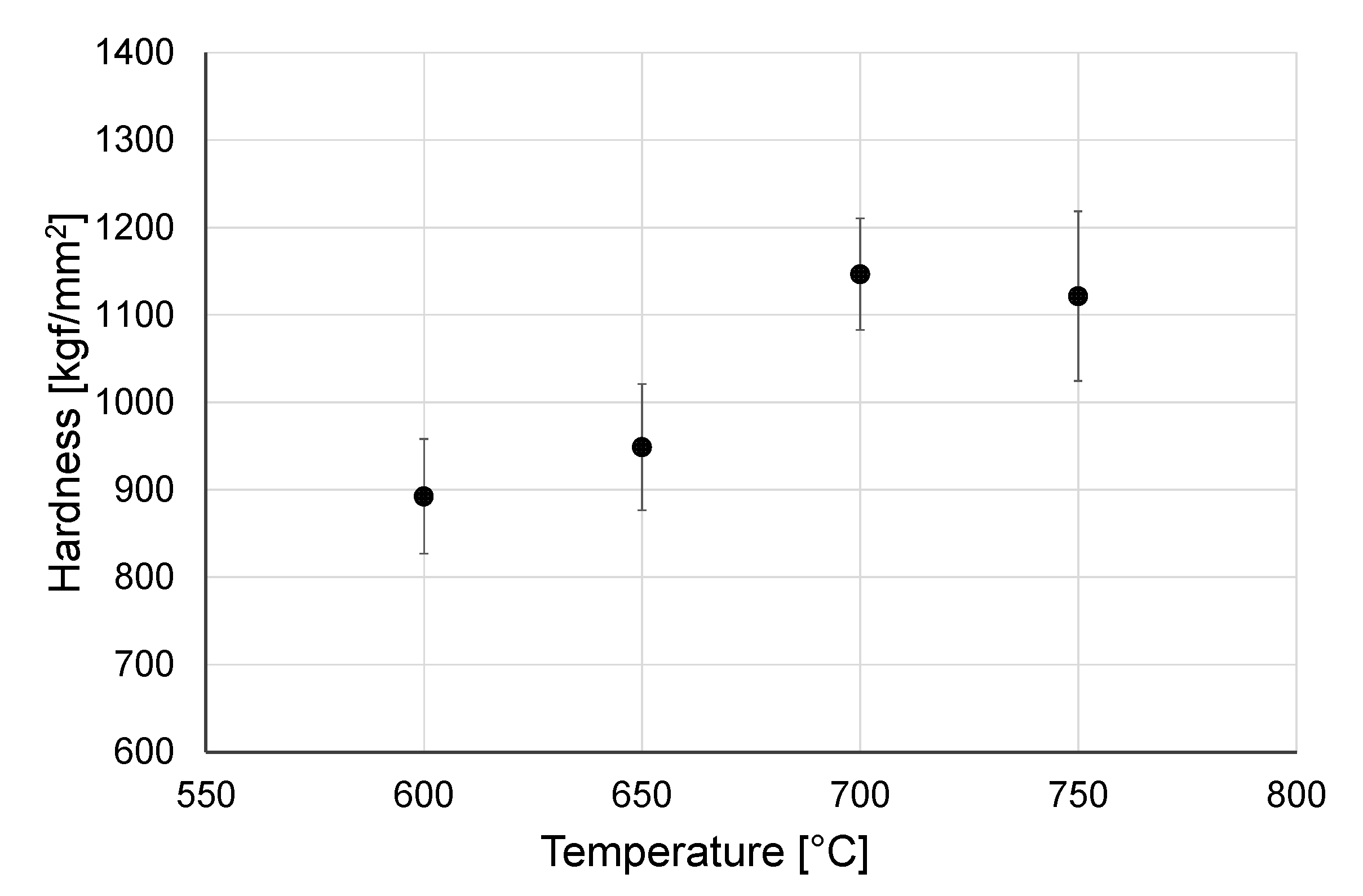
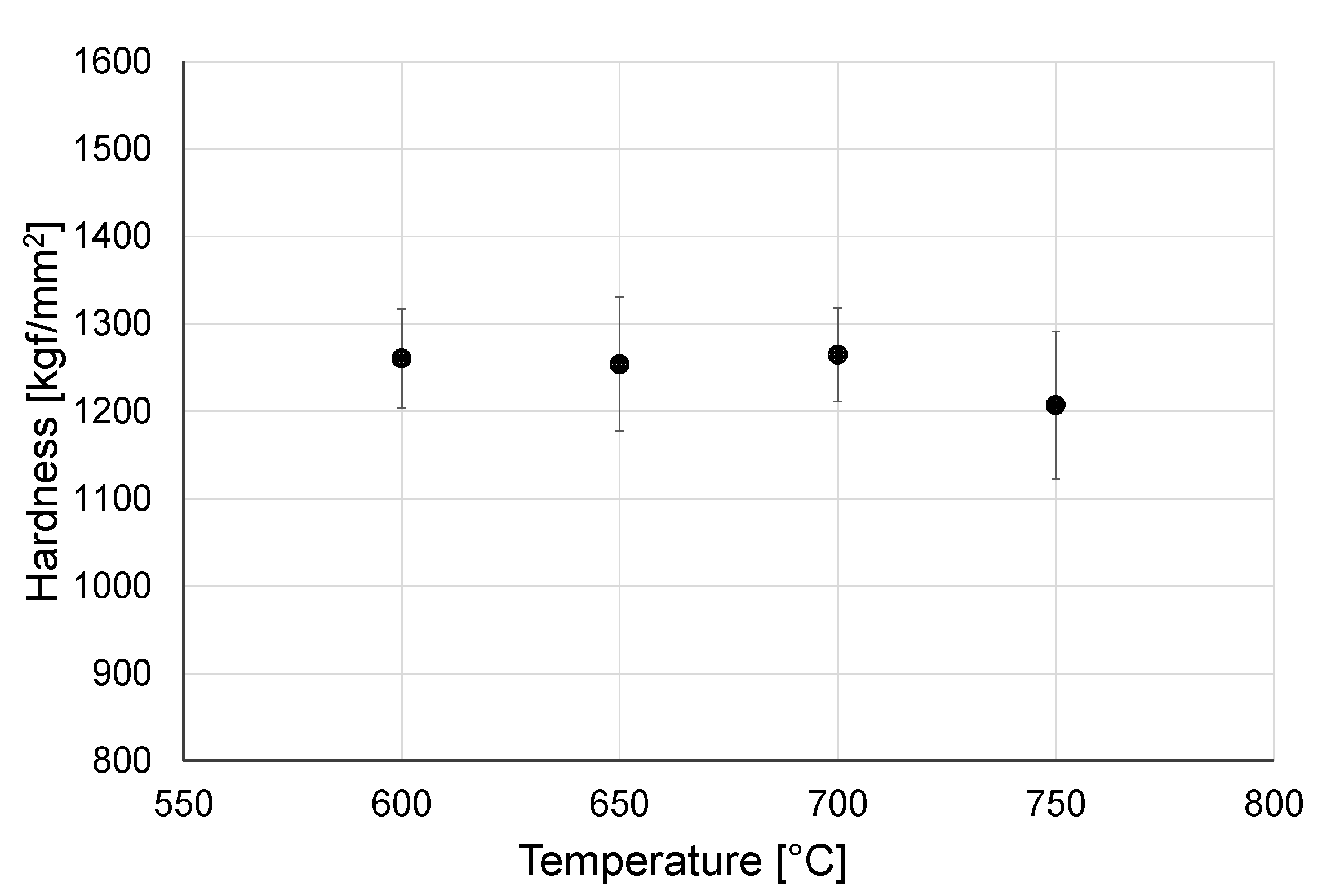
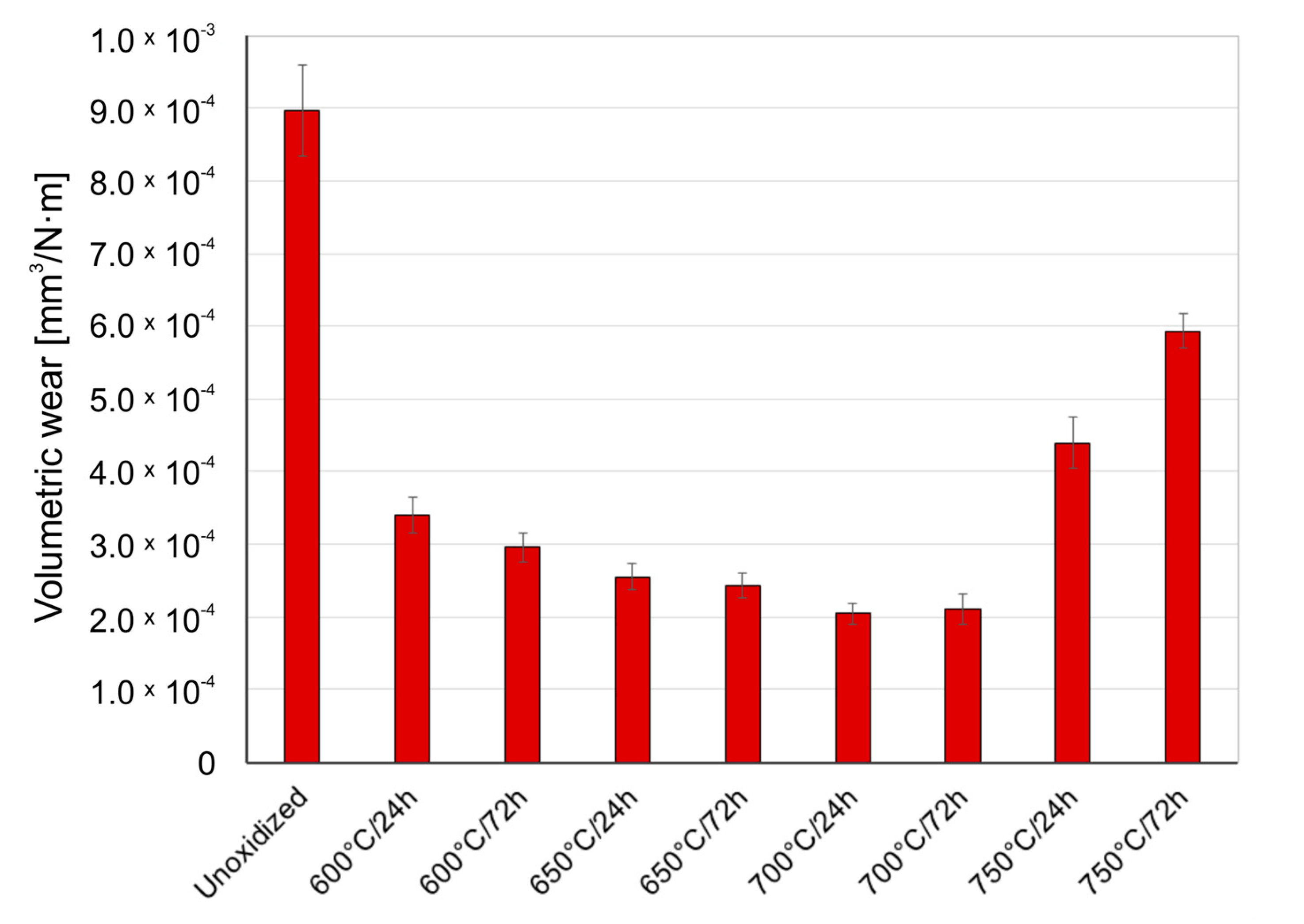
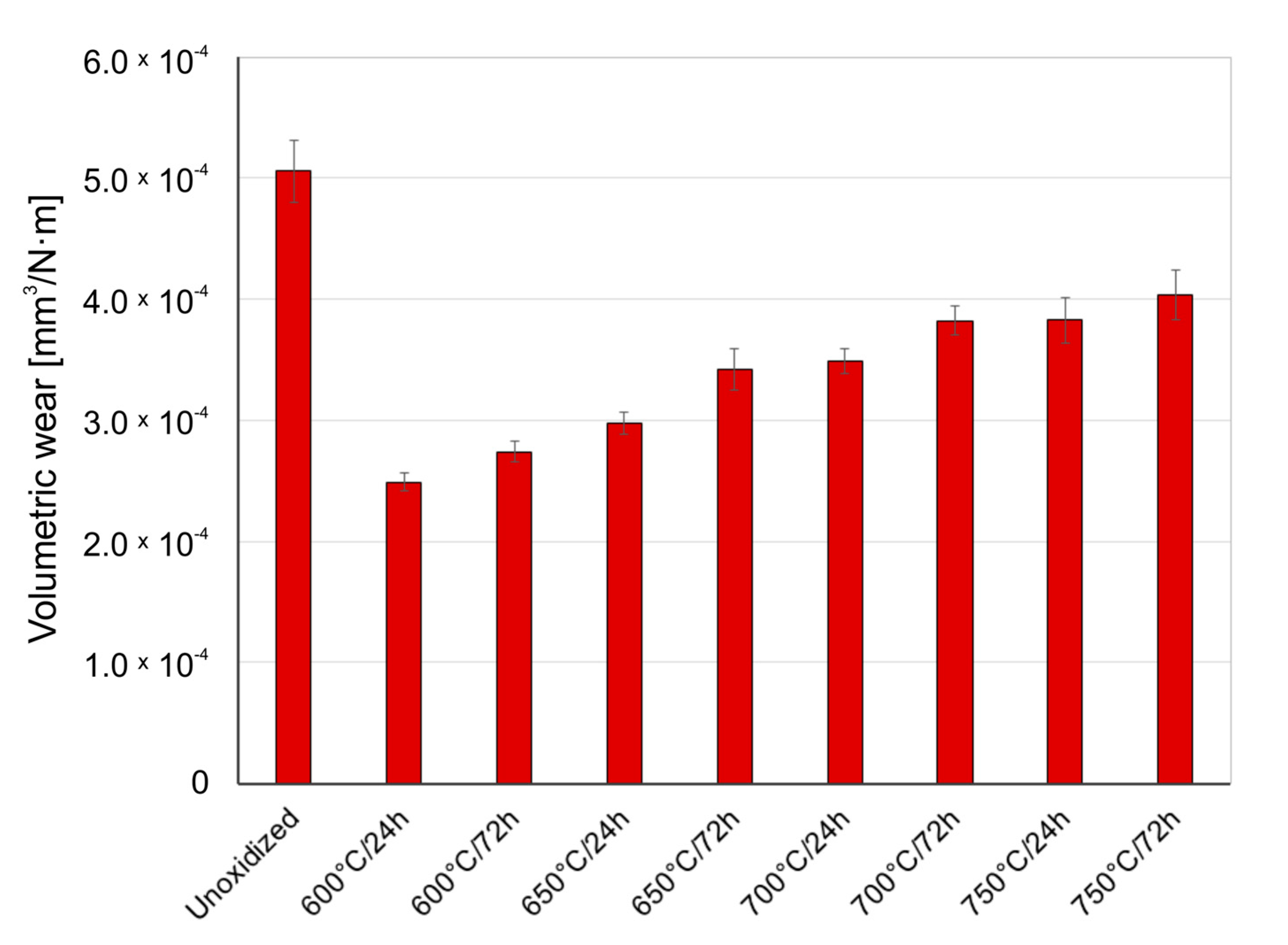
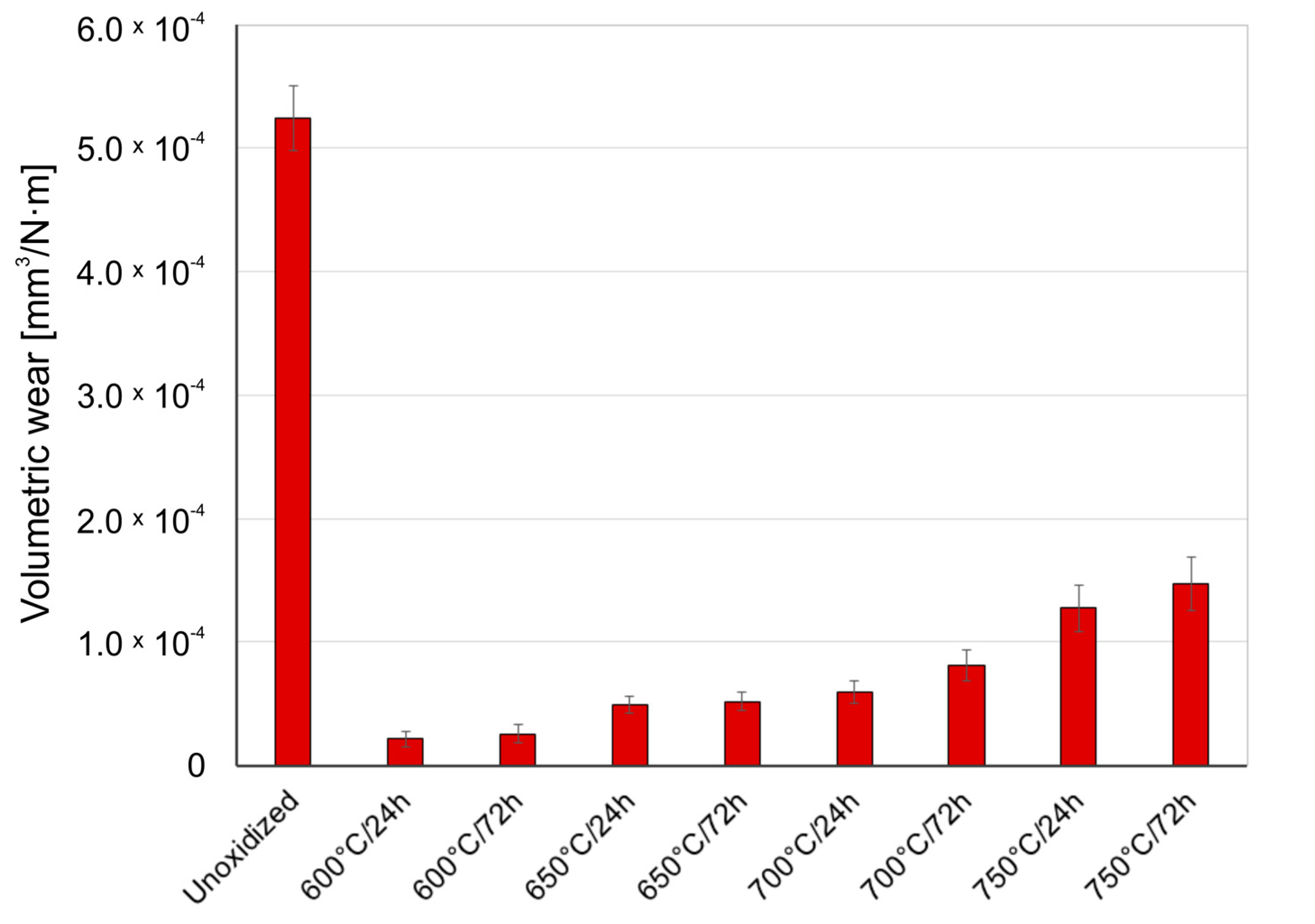
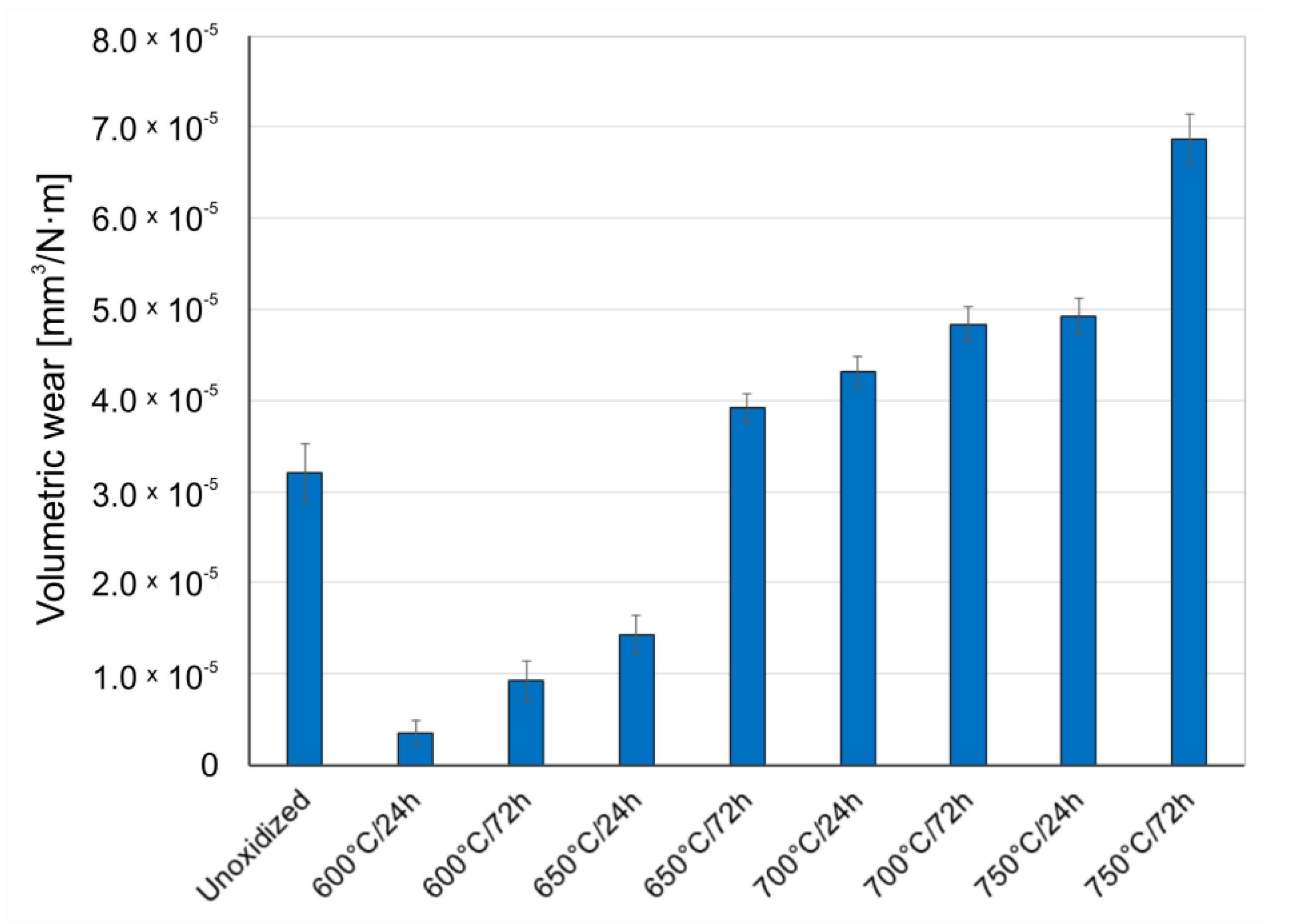
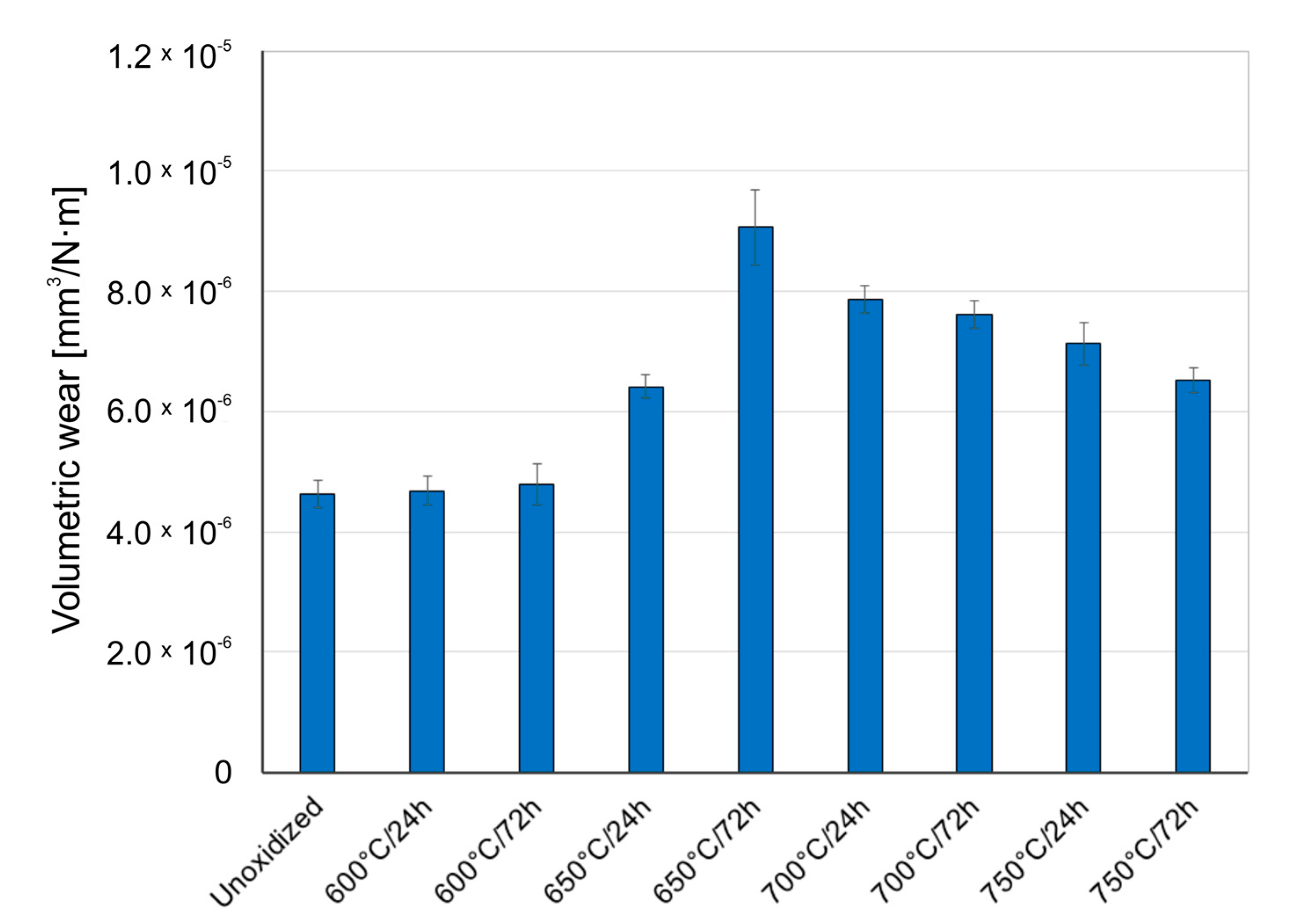
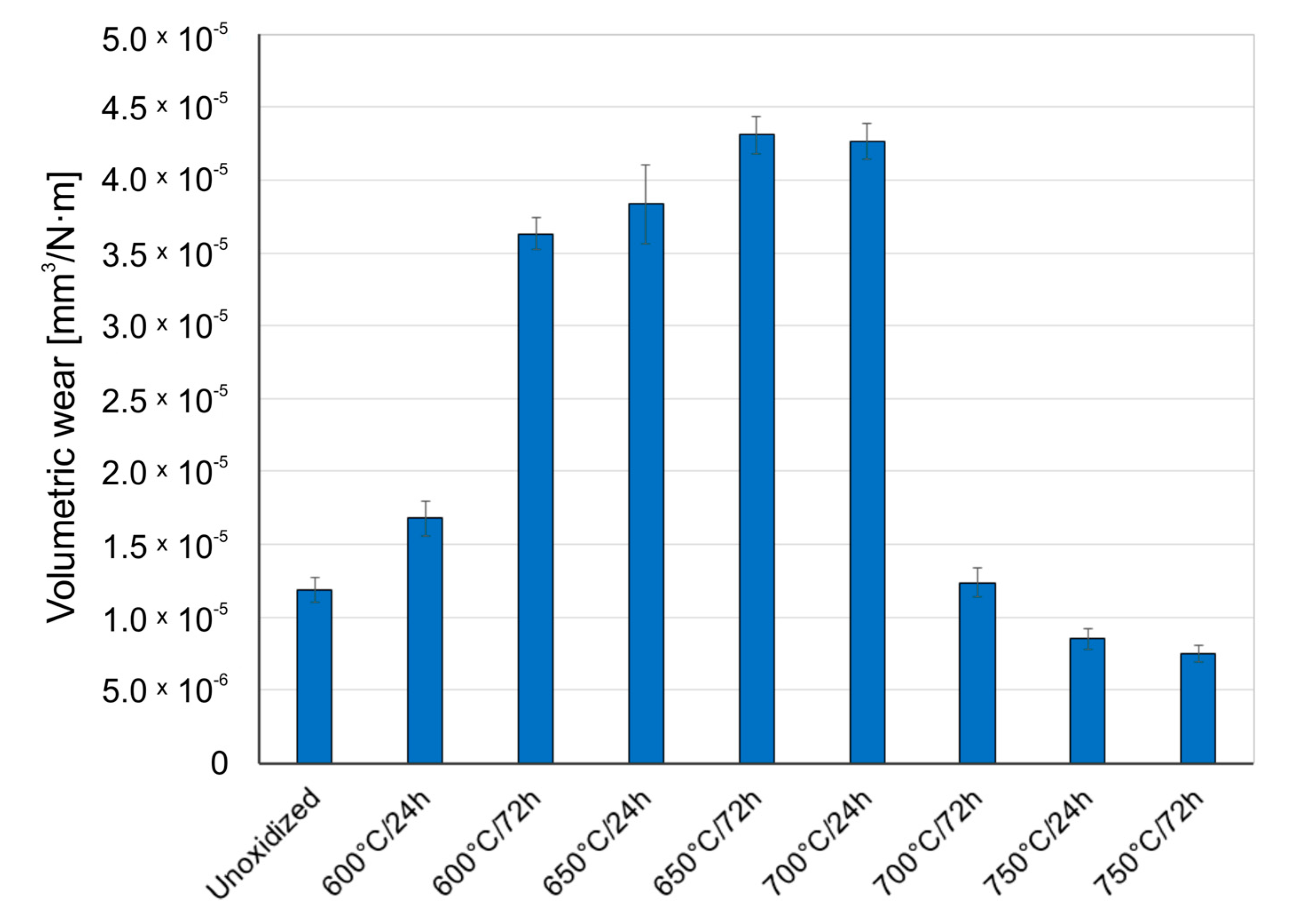
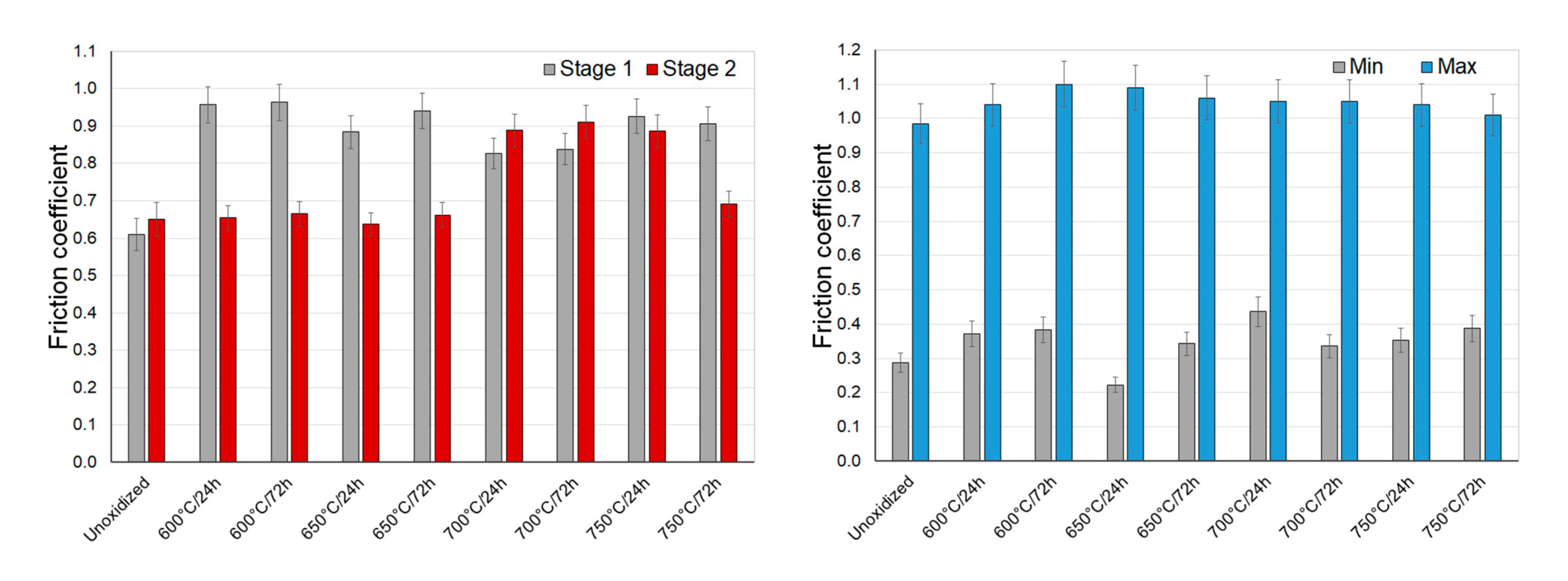
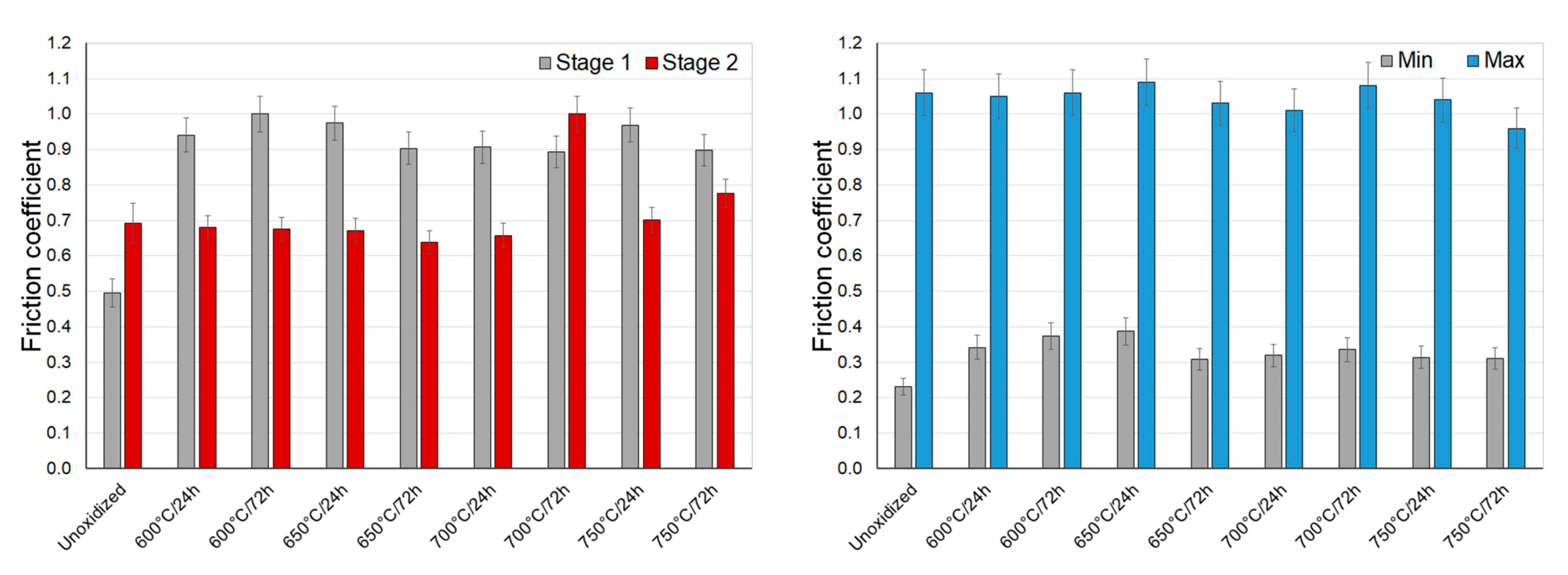
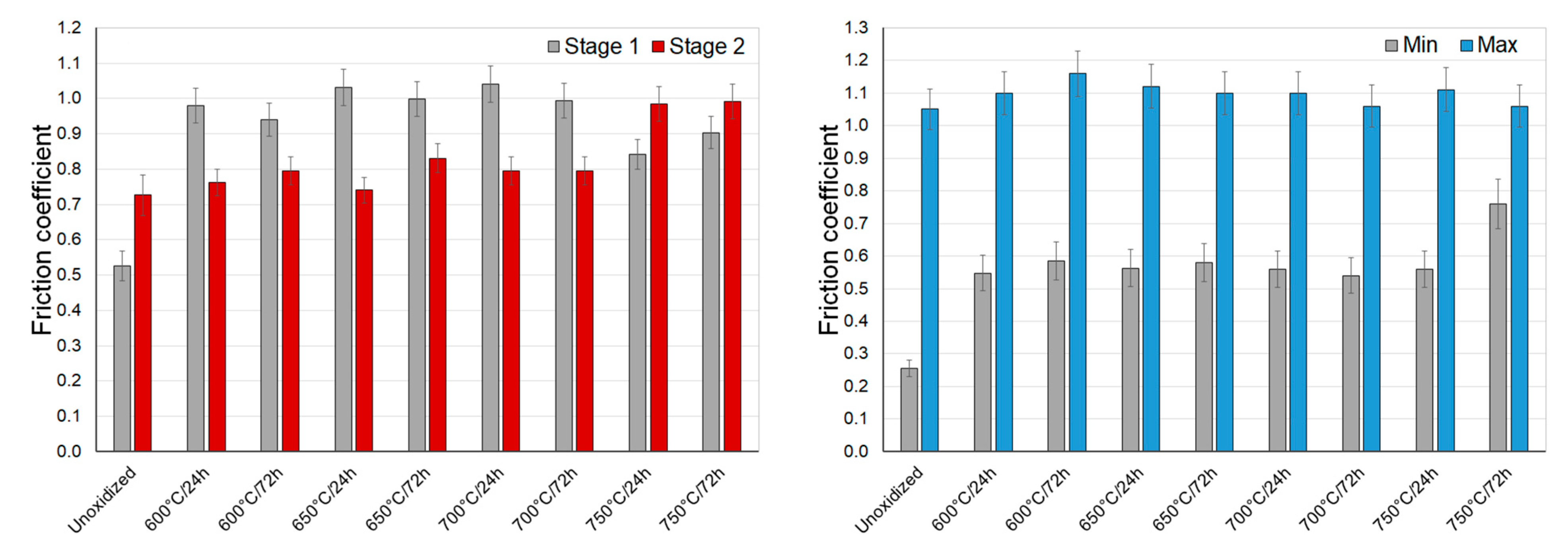

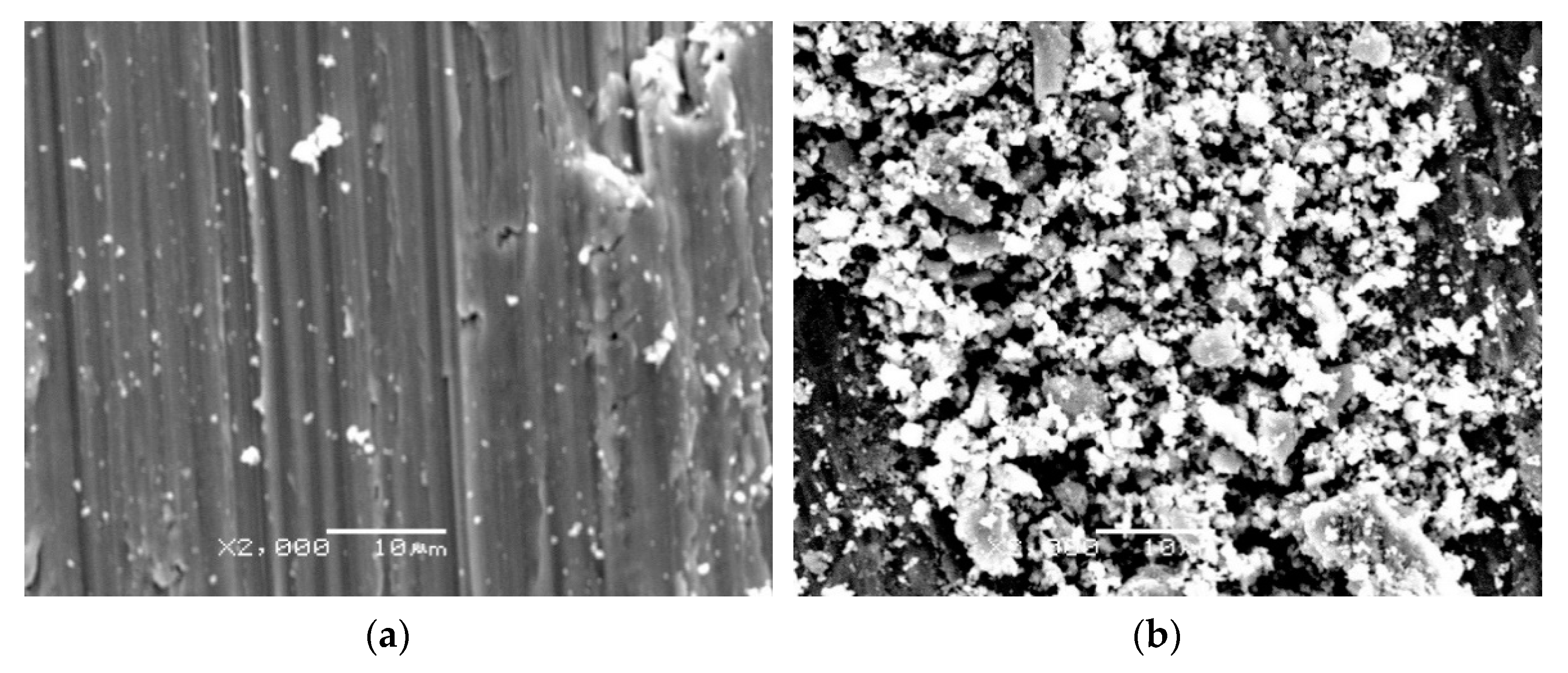
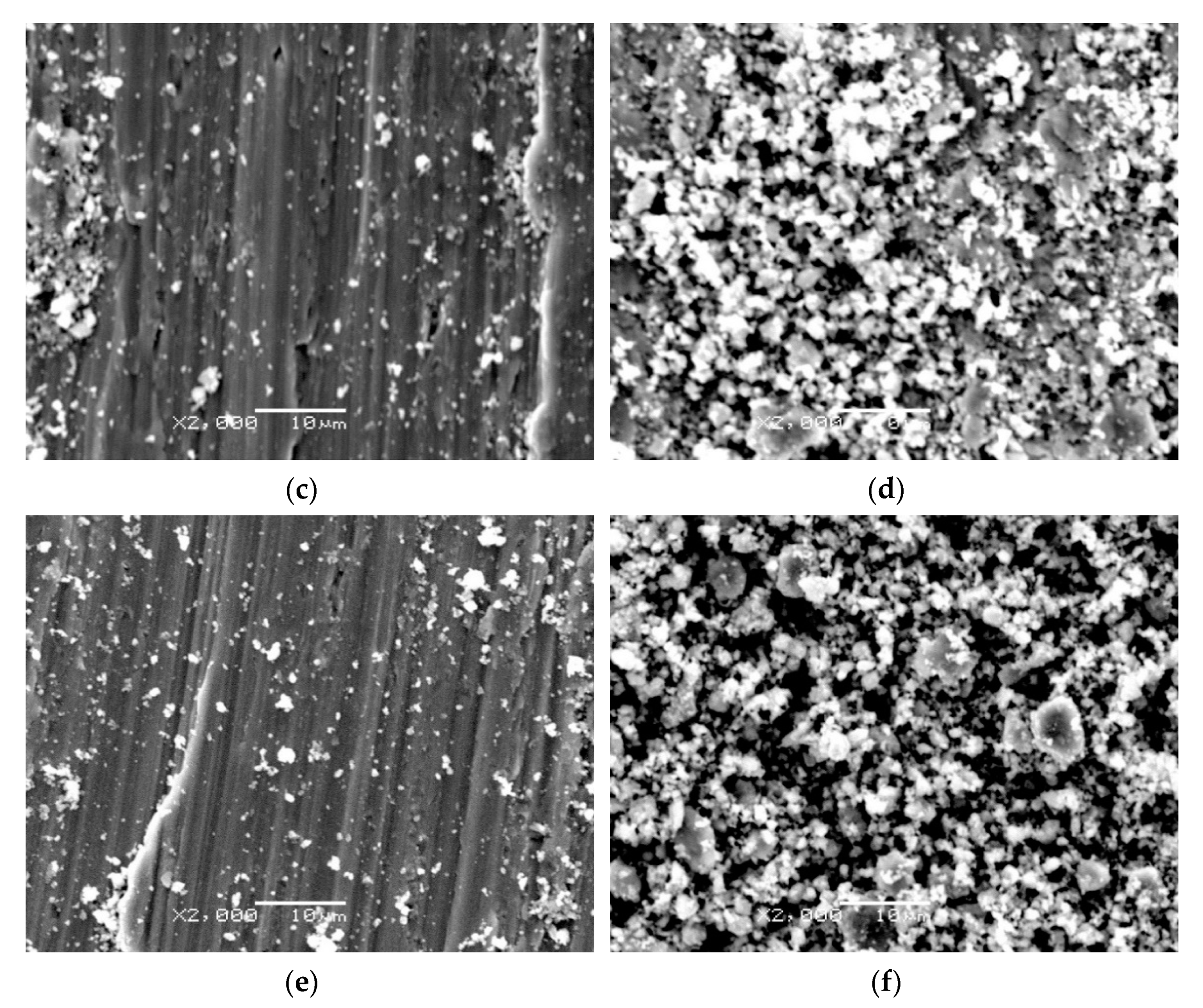
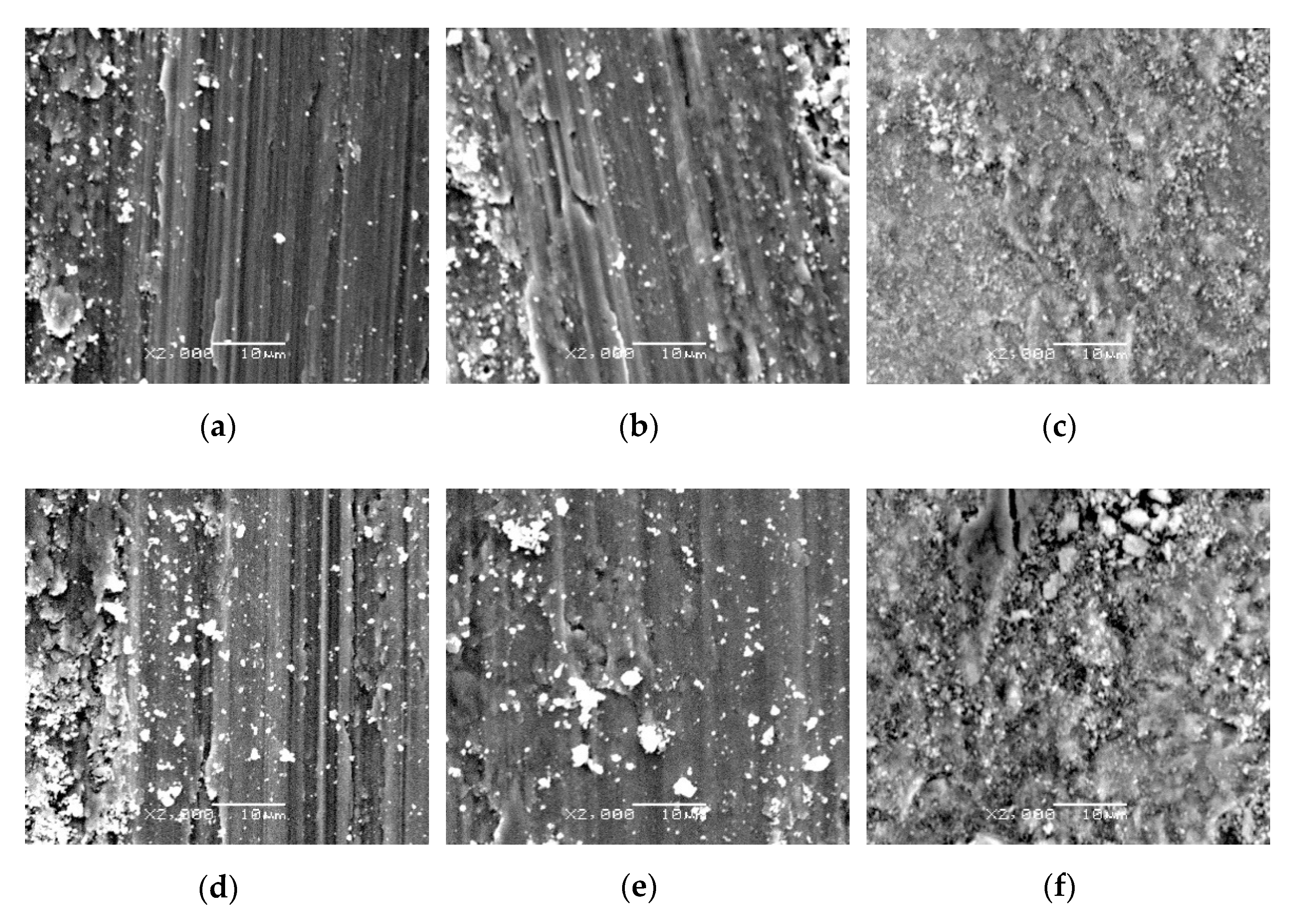


| Material | Components Content, wt%. | |||||
|---|---|---|---|---|---|---|
| C | Fe | H | N | O | Ti | |
| TiGr2 | 0.008 | 0.13 | 0.0019 | 0.010 | 0.18 | Rest |
| Requirement | ≤0.08 | ≤0.3 | ≤0.015 | ≤0.03 | ≤0.25 | Rest |
| Property | Unit | Al2O3 | ZrO2 | 100Cr6 |
|---|---|---|---|---|
| Density | (g/cm3) | 3.9 | 6.0 | 7.8 |
| Young’s modulus | (GPa) | 370 | 213 | 200 |
| Friction coefficient | - | 0.2 | 0.2 | - |
| Specific heat | J/kg·K | 795 | 450 | 464 |
| Coefficient of linear thermal expansion | 10−6/°C | 7.3 | 9.8 | 12.3 |
| Thermal conductivity | W/m·K | 31.0 | 3.3 | 42.4 |
| Ultimate compressive strength | MPa | 2600 | 2500 | 2500 |
| Speed | (m/s) | 0.1 |
| Load | (N) | 5 |
| Friction distance | (m) | 1000 |
| Air temperature | (°C) | 21 ± 1 |
| Humidity | (%) | 50 ± 5 |
Publisher’s Note: MDPI stays neutral with regard to jurisdictional claims in published maps and institutional affiliations. |
© 2021 by the authors. Licensee MDPI, Basel, Switzerland. This article is an open access article distributed under the terms and conditions of the Creative Commons Attribution (CC BY) license (https://creativecommons.org/licenses/by/4.0/).
Share and Cite
Aniołek, K.; Barylski, A.; Kupka, M. Friction and Wear of Oxide Scale Obtained on Pure Titanium after High-Temperature Oxidation. Materials 2021, 14, 3764. https://doi.org/10.3390/ma14133764
Aniołek K, Barylski A, Kupka M. Friction and Wear of Oxide Scale Obtained on Pure Titanium after High-Temperature Oxidation. Materials. 2021; 14(13):3764. https://doi.org/10.3390/ma14133764
Chicago/Turabian StyleAniołek, Krzysztof, Adrian Barylski, and Marian Kupka. 2021. "Friction and Wear of Oxide Scale Obtained on Pure Titanium after High-Temperature Oxidation" Materials 14, no. 13: 3764. https://doi.org/10.3390/ma14133764
APA StyleAniołek, K., Barylski, A., & Kupka, M. (2021). Friction and Wear of Oxide Scale Obtained on Pure Titanium after High-Temperature Oxidation. Materials, 14(13), 3764. https://doi.org/10.3390/ma14133764








